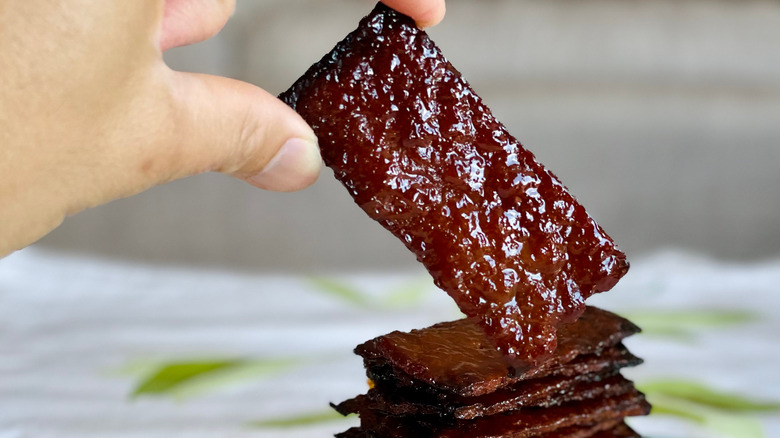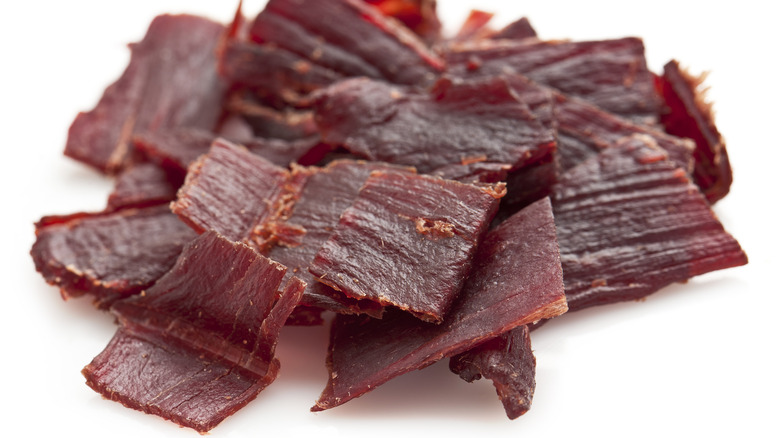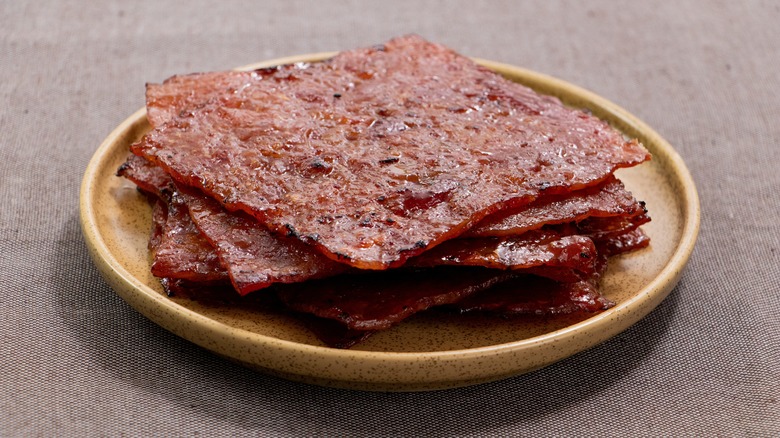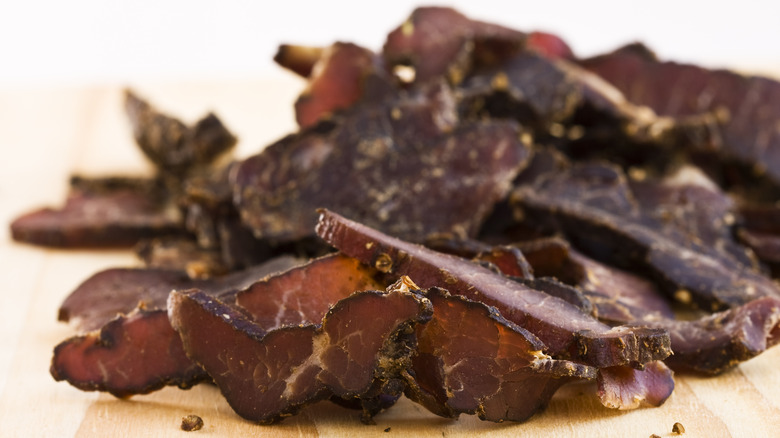The Umami-Packed Difference Between Chinese Pork Jerky And American Jerky
Many delicious food innovations came about through necessity. Such is the case for dried meats, which emerged globally in places like Ancient Egypt, the Americas, and China. Across locales, the premise was the same: Preverse some of the meat's nutritional content for extended periods. Across cultures, the influence of local ingredients and culinary techniques created distinct renditions.
While jerky may be associated with its smokey and sweet palate in the U.S., it takes on many more forms elsewhere. From meaty and air-dried biltong popular in Africa to shredded, topping-like Mexican Machaca, global renditions showcase the malleability of the dish. In China, a dried meat preparation is called bak kwa, which comes as a thin, dried sheet of pork. Very savory, spiced, and slightly sweet, the food is finished on a grill, which lends it a unique character. For jerky lovers, such an umami-forward style carries distinct differences from the classic American type.
What is Chinese pork jerky?
In China, dried beef preparation dates back over 2,000 years. While the precise origin of the pork jerky variety is unknown, it does have historical roots in the Fujian province. Due to meat shortages, the dish came about as a method of preservation, especially for Lunar New Year. As a result, the dish continues to be interlinked with Chinese celebrations. Plus, Fujianese immigrants brought the food to Malaysia and Singapore, too, where it's now commonly enjoyed.
While there are now many varieties of bak kwa, the general preparation follows a similar process. First, the pork is sliced into thin slivers, or minced meat is formed into a patty. Then, the protein is marinated in a mixture of sauces like oyster, soy, and Shaoxing wine, along with spices and sugar. The meat then goes through an air-drying process before it's finished on a hot plate or over a live fire. This process lends the jerky its distinct dark orange-brownish tint, as well as a complex savory taste.
What is American jerky?
American-style jerky emerged as a combination of Native American techniques matched with colonial preparation. Indigenous tribes would smoke, salt, and flavor protein sources, especially bison, for later consumption. In fact, the name for jerky emerged from the Quechua word "ch'arki", a preparation style absorbed by European colonizers. In North America, locals would craft a variant called pemmican, which is comprised of protein sources slowly dehydrated with sun or fire. They'd then be chopped alongside nuts and berries to form nutrient-dense snacks.
Early colonists, explorers, and later cowboys adopted the drying aspects of the preparation, but with their own components. Beef brought to the Americas became incorporated into the mix, followed by more modern flavorings, like Worcestershire sauce, brown sugar, and varying powders. Nevertheless, American jerky still favors the dry and chewy jerky style, especially due to its durability. The employed protein is dehydrated over a slow-simmering duration. And the process is no longer limited to hunted animals; American jerky comes together from a wide variety of bases and flavors. As a result, the term encompasses a wide-ranging array of preparations.
Chinese pork jerky offers a distinct, sticky texture
Due to distinct preparation techniques, the two jerky varieties take on different consistencies. The pork employed in Chinese jerky is either sliced very thin or crafted from a mince. Following its marination, it's traditionally air-dried, although some modern renditions are baked. However, most critically, the pork is covered in a glaze before a finish on the grill or in the broiler. This step creates delicious caramelization, which lends the pork a sticky mouthfeel. In combination with its thin texture, Chinese pork jerky has an almost gooey, tender texture.
Alternatively, American jerky is all about the chew. Old-school styles have an almost leather-like quality; however, modern preparations have perfected marination and dehydration for a bit more softness. Depending on the utilized protein, as well as the employed meat cut, there's quite a lot of variation in texture. Nevertheless, the aim is a shelf-stable product with very low moisture. Achieved through a low-heat, long cooking process, this quality connects the product to its historical roots.
The two jerky styles encompass many variations
Both jerky styles have a classic flavor palate that has now expanded to a wider array of interpretations. For American jerky, it's quintessentially a beef base, flavored with simple ingredients like salt and pepper, and underlaid with a smokey note. Meanwhile, bak kwa relies on pork, as per its translated name. Its complex mix of sauces and spices lends a balance of sweetness and savouriness, a palate unique to the style.
However, both foods have evolved into many new renditions. The appetite for American jerky has inspired a wide range of proteins, from mushrooms, to turkey, fish, wild game, and more. Plus, the flavorings take on many creative forms; from lemon pepper to teriyaki, the sky is the limit for combinations.
And while Chinese pork jerky often holds to a more traditional take, there's still much creative reinterpretation of the dish. Crafted with beef, duck, and even lobster, preparation is no longer limited to pork. Plus, some serve the protein in expertly crafted sandwiches, pies, and more; showcasing the ever-expanding nature of the dish.




